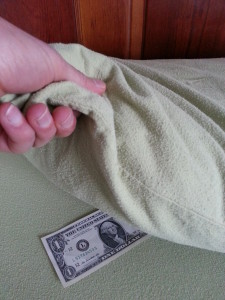by Kerry Maiorca
Satya, truth. It’s the second of the yamas, or ethical guidelines, from the Yoga Sutras, and one that most yogis unequivocally agree upon as a core tenant of practice and conscious living.
But if we’re talking truth, I need to fess up. Though I regularly draw from the principles of yoga in my personal and professional life, as a parent truth is a gray, wavy tightrope I walk with my kids.
To clarify, I’m big on being truthful about most things, including hard truths like death and pain and sadness that would be easier to avoid or bend. But when my kids were young and friends concerned about the ethics of lying to children asked me whether we would do the whole Santa, Easter Bunny, and Tooth Fairy thing, I didn’t hesitate to say yes.
My son lost his first tooth at the Shedd Aquarium on a Kindergarten Field Trip. He had innocently gone to see some fish and came home missing a part of his baby self, not yet replaced by adulthood. He taped the tiny thing to a piece of paper and wrote in all caps “TOOTH,” with an arrow pointing it all out for the tooth fairy, lest she not be the sharpest incisor in the mouth. Then he went to sleep, anticipating the magic (and terror) that accompanies the lore of this small creature who sneaks into your bedroom while you sleep to exchange teeth for money.
I painstakingly wrote out the note, trying to make up what I thought would be an appropriate tooth fairy font, then I walked casually into his room rather than tiptoeing as I had imagined I would when daydreaming about this moment. If he woke up and saw me I decided I’d just pretend I was going in for one more kiss goodnight, hoping he’d be too groggy to remember to check his tooth hiding place.
As I slipped the note and the $1 bill underneath, I thought about my own parents and the years of surprises and pretending they gifted to me, the love that was reflected in the half-eaten carrot left next to my Easter basket or my parents’ alternating tooth fairy handwriting for each tooth I lost: one fairy earnest and encouraging, the other biting and slightly abrupt. This business of creating stories and rituals and special moments, even when it’s pretty much outright lying, is anything but a betrayal. Rather it’s a way of showing love for our children and celebrating magic in an often mundane and unsurprising world. Black-and-white adherence to an ethical principle can oversimplify things. While the tooth fairy is untrue in one sense, in another it embodies and bonds families over one of the deepest truths of childhood: stories, fictional or otherwise, make life more fun.
The next morning as I heard my son stirring in his bed, I waited for it – the rustle of the sheets, the little half-gasp, the feet scurrying down the rungs of the ladder of his bunk bed, and the pat-pat-pat as he ran down the hallway and jumped into bed with us to show off his winnings. My surprise and awe, though not necessarily about the existence of a fairy, was completely genuine and wholly exhilarating.


























No Responses to “The Householder Yogi: Satya and the Tooth Fairy”